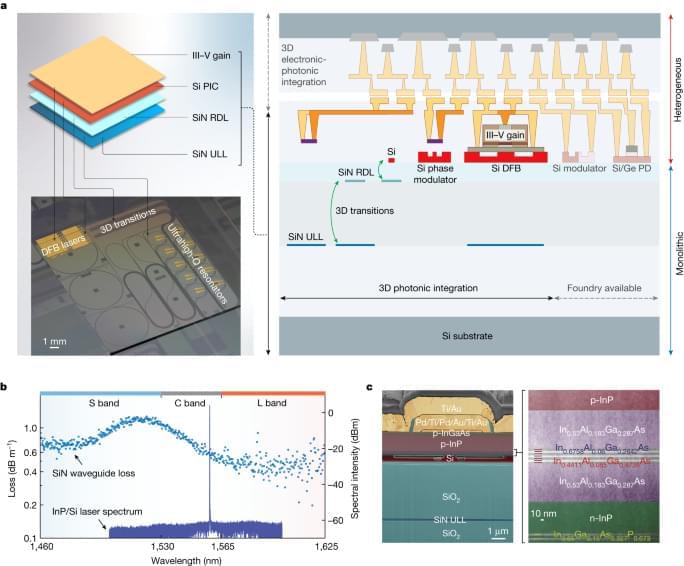Detecting the permanent imprints left by colliding black holes would reveal a universe saturated with infinite symmetries – and narrow the possibilities for a theory of quantum gravity.



Euclid, a space mission led by the European Space Agency.
The European Space Agency (ESA) is an intergovernmental organization dedicated to the exploration and study of space. ESA was established in 1975 and has 22 member states, with its headquarters located in Paris, France. ESA is responsible for the development and coordination of Europe’s space activities, including the design, construction, and launch of spacecraft and satellites for scientific research and Earth observation. Some of ESA’s flagship missions have included the Rosetta mission to study a comet, the Gaia mission to create a 3D map of the Milky Way, and the ExoMars mission to search for evidence of past or present life on Mars.
Quantum entanglement is one of the most intriguing and perplexing phenomena in quantum physics. It allows physicists to create connections between particles that seem to violate our understanding of space and time.
This video discusses what quantum entanglement really is, and the experiments that help us understand it. The results of these experiments have applications in new technologies that will forever change our world.
Join Katie Mack, Perimeter Institute’s Hawking Chair in Cosmology and Science Communication, over 10 short forays into the weird, wonderful world of quantum science. Episodes are published weekly, subscribe to our channel so you don’t miss an update.
Want to learn more about quantum concepts? Visit https://perimeterinstitute.ca/quantum-101-quantum-science-explained to access free resources.
Follow Perimeter:
Twitter: https://twitter.com/Perimeter.
LinkedIn: https://www.linkedin.com/company/perimeter-institute/
Instagram: https://www.instagram.com/perimeterinstitute/
Facebook: https://www.facebook.com/pioutreach.
Perimeter Institute (charitable registration number 88,981 4323 RR0001) is the world’s largest independent research hub devoted to theoretical physics, created to foster breakthroughs in the fundamental understanding of our universe, from the smallest particles to the entire cosmos. Be part of the equation: https://perimeterinstitute.ca/donate

If two statisticians were to lose each other in an infinite forest, the first thing they would do is get drunk. That way, they would walk more or less randomly, which would give them the best chance of finding each other. However, the statisticians should stay sober if they want to pick mushrooms. Stumbling around drunk and without purpose would reduce the area of exploration, and make it more likely that the seekers would return to the same spot, where the mushrooms are already gone.
Such considerations belong to the statistical theory of “random walk” or “drunkard’s walk,” in which the future depends only on the present and not the past. Today, random walk is used to model share prices, molecular diffusion, neural activity, and population dynamics, among other processes. It is also thought to describe how “genetic drift” can result in a particular gene—say, for blue eye color—becoming prevalent in a population. Ironically, this theory, which ignores the past, has a rather rich history of its own. It is one of the many intellectual innovations dreamed up by Andrei Kolmogorov, a mathematician of startling breadth and ability who revolutionized the role of the unlikely in mathematics, while carefully negotiating the shifting probabilities of political and academic life in Soviet Russia.

Following the path of electronic integrated circuits (EICs), silicon (Si) photonics holds promises to enable photonic integrated circuits (PICs) with high densities, advanced functionality and portability. Although various Si photonics foundries are rapidly developing PIC capabilities—enabling volume production of modulators, photodetectors and most recently lasers—Si PICs have yet to achieve the stringent requirements on laser noise and overall system stability imposed by many applications such as microwave oscillators, atomic physics and precision metrology9,10,11. Semiconductor lasers must strongly suppress amplified-spontaneous-emission noise to achieve narrow linewidth for these applications12. They will also require isolation from the rest of the optical system, otherwise the laser source will be sensitive to back-reflections from downstream optical components that are beyond the control of the PIC designer13. In many integrated photonic solutions, a bulk optical isolator must be inserted between the laser chip and the rest of the system, significantly increasing the complexity, as well as the cost of assembly and packaging14.
To enrich the capabilities of Si PICs and avoid multi-chip optical packaging, non-group-IV materials need to be heterogeneously integrated to enable crucial devices, including high-performance lasers, amplifiers and isolators15,16,17. It has now been widely acknowledged that group III–V materials are required to provide efficient optical gain for semiconductor lasers and amplifiers in Si photonics regardless of the integration architecture, but concerns still remain for a complementary metal–oxide–semiconductor (CMOS) fab to incorporate magnetic materials, which are currently used in industry-standard optical isolators18.
Fortunately, a synergistic path towards ultralow laser noise and low feedback sensitivity exists—using ultrahigh-quality-factor (Q) cavities for lasers that not only reduce the phase noise but also enhance the feedback tolerance to downstream links. These effects scale with the cavity Q and ultrahigh–Q cavities would thus endow integrated lasers with unprecedented coherence and stability19,20. The significance is twofold. First, the direct integration of ultralow-noise lasers on Si PICs without the need for optical isolators simplifies PIC fabrication and packaging. Furthermore, this approach does not introduce magnetic materials to a CMOS fab as isolators are not obligatory for such complete PICs.

Great for if you forget but I’m sure they’re gonna make a dystopian movie or few about this. I don’t remember the TV series or maybe it was a movie I saw a trailer for but in it they had a thing similar to TSA where as you go from city to city etc the AI or computer reads your mind and if you had any rebellious or offensive thoughts towards the government they’d arrest you. Scary huh! I myself have joked that if con is the opposite of pro the Congress is the opposite of progress. Haha.
By examining a person’s brain activity, artificial intelligence (AI) can produce a song that matches the genre, rhythm, mood and instrumentation of music that the individual recently heard.
Scientists have previously “reconstructed” other sounds from brain activity, such as human speech, bird song and horse whinnies. However, few studies have attempted to recreate music from brain signals.

A three-member team spent four years building the low-latency bot which responds faster than the time it takes for an eye to blink.
Shandong, China-based Qibot Robot Company claims to have built the world’s fastest boxer bot. Standing over six feet (1.9 m) tall, the bot is a single-handed robot that can be teleoperated and has a response delay time of just 12 milliseconds, which according to the company, makes it the world’s fastest, the South China Morning Post.
Just as robots are being built to replace humans in tedious and repetitive tasks, they are also great alternatives facing violence. Militaries worldwide are looking to increase the use of drones to keep humans out of danger zones, and robot wars aren’t an alien concept for most people today.
Matthias G. Fischer et al., 2023/bioRxiv.
A report suggests that our planet is home to 1031 viruses, and they are probably the most powerful beings in terms of population. They come in all kinds of shapes and forms, however, some are more bizarre than others.

Scientists have discovered a new way to accomplish fast data transmissions through light-emitting diode (LED) bulbs.
While research has progressed in significantly optimizing light-emitting diodes (LEDs), the modulation characteristics of perovskite LEDs remain unclear.
In recent developments, scientists have discovered a new way to transmit data quickly through LEDs. This could allow homes and offices to use the fast internet through lights instead of setting up a wifi router.